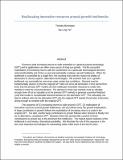Reallocating innovative resources around growth bottlenecks
Author(s)
Bresnahan, Timothy; Yin, Pai-Ling
DownloadRIRAGB_REVISION.pdf (194.7Kb)
OPEN_ACCESS_POLICY
Open Access Policy
Creative Commons Attribution-Noncommercial-Share Alike
Terms of use
Metadata
Show full item recordAbstract
Economy-wide increasing returns to scale embodied in a general purpose technology (GPT) and its applications are often a key source of long-run growth. Yet the successful exploitation of increasing returns calls for coordination on a particular technological direction, reducing flexibility and choice ex post and potentially creating a growth bottleneck. When the bottleneck is controlled by a single firm, the resulting entry barriers reduce the ability of demanders to choose superior, alternative technologies. We examine how such a growth bottleneck can eventually be overcome under certain key conditions. Demand must be fundamentally diverse so that the original GPT does not serve all demanders. Firms barred from entry into the primary GPT market can then reallocate innovative resources to create new markets to meet the unserved demand. The demand in these new markets must be valuable enough (even if not as valuable as in the primary GPT market) to generate a positive-feedback cycle that results in considerable technical advance in the alternative GPT. This ultimately can lead to indirect entry by the alternative GPT into the original GPT market if and when it becomes strong enough to compete with the original GPT. This sequence of (i) increasing returns to scale around a GPT, (ii) reallocation of innovative resources around growth bottlenecks, and (iii) indirect entry has growth implications. A large contribution to growth follows the exploitation of increasing returns to scale in the original GPT. Much later, another large contribution to growth follows when demand is finally met by an alternative, competitive GPT. Between these two periods falls a period of lesser contributions to growth due to the dominant firm bottleneck. The market-based resolution of the bottleneck is not merely a theoretical possibility. We illustrate the role of this sequence in the two most important technologies for automating white-collar work of the past 50 years.
Date issued
2010-09Department
Sloan School of ManagementJournal
Industrial and Corporate Change
Publisher
Oxford University Press
Citation
Bresnahan, T., and P.-L. Yin. “Reallocating innovative resources around growth bottlenecks.” Industrial and Corporate Change 19 (2010): 1589-1627. Web. 16 Dec. 2011.
Version: Author's final manuscript
ISSN
1464-3650
0960-6491